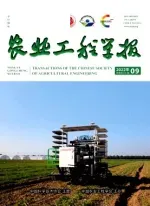连续单粒式谷物在线水分测定仪的设计与试验
2017-07-12吴惠昌谢焕雄胡志超顾峰玮游兆延颜建春
吴惠昌,谢焕雄,胡志超,顾峰玮,游兆延,颜建春,魏 海
(农业部南京农业机械化研究所,南京 210014)
·农产品加工工程·
连续单粒式谷物在线水分测定仪的设计与试验
吴惠昌,谢焕雄,胡志超※,顾峰玮,游兆延,颜建春,魏 海
(农业部南京农业机械化研究所,南京 210014)
为了提高谷物干燥设备自动化水平和干燥后谷物品质,提出一种基于电阻法检测原理,测量稻谷、小麦和大麦的连续单粒式谷物在线水分测定仪。其主要由谷物取样机构、谷物采样机构和信号采集电路等部分组成。通过测量谷物单粒外形尺寸统计出谷物等效粒径。运用谷物等效粒径和谷物与金属表面的静滑动摩擦角,计算确定谷物取样机构中不锈钢制异向正弦螺旋杆的中径和螺距分别为16和9 mm。由螺旋杆与分粒拨刀组成的谷物取样机构,在剔除杂物和多余谷物的同时,使谷物以连续单粒的形式进入进料口。选定模数为0.4 mm斜纹表面滚花形式碾压辊作为碾压电极,测量10%~35%含水率范围内稻谷、小麦和大麦单粒电阻值。构建稻谷、小麦和大麦的单粒阻值-含水率对应关系曲线并回归出水分计算函数(稻谷R2=0.998;小麦R2=0.999;大麦R2=0.999)。设计多路复用比例检测电路、二阶压控有源低通滤波器和50Hz陷波等信号处理电路。采用基于ARM CortexTM-M3核的低功耗32位微处理器硬件和软件平台完成谷物水分数据的采样、处理和计算。现场水分在线检测与烘干法对比试验表明,在循环式谷物烘干机烘干过程−5~55 ℃的谷物温度和10%~35%含水率范围内,单粒式在线水分测定仪的在线水分测量绝对误差≤±0.4%,一次100粒谷物测量平均时间≤55s,水分测量重复误差≤±0.3%,研究结果为实现谷物烘干过程水分在线检测提供参考。
谷物;水分;电阻;单粒式;STM32低功耗微处理器
0 引 言
谷物干燥是粮食安全储藏的重要环节[1-4]。近年来,中国谷物干燥模型解析理论及控制技术研究取得了较大突破,尤其在谷物水分结合能及干燥系统热能结构解析方面[5-8],实现利用客观干燥势进行高效节能干燥,创制出多种谷物干燥自适应控制系统[9-12]。但谷物烘干过程中水分在线精确检测仍是制约谷物干燥系统开发的核心技术难点。
谷物水分检测原理主要有电阻法、电容法、微波法、红外法、中子法、核磁共振法等。微波法、红外法及电容法均受谷物的形状、厚度、密度以及粒体内部的水分分布等因素影响,检测精度和重复性较低[13-17]。中子法和核磁共振法系统复杂,造价高,现阶段还不能用于谷物干燥过程的水分在线测量[18-21]。电阻法依据谷物不同含水率对应不同的导电率原理检测谷物水分,是谷物在线水分仪普遍采用的方法,如日本三久和无锡金子烘干控制系统均自带基于电阻法的单次多粒式水分仪,与烘干设备成套提供;李长友等设计出具有纵向采料盘的电阻式单粒稻谷水分仪[22];张永林等采用阻-频转换和智能非线性处理算法设计单粒式谷物水分仪[23];梅庆等采用单螺旋杆挤压测阻机构设计谷物在线水分仪[24]。但针对电阻法存在阻值分布范围极宽、采样信号幅值小、取样要求高和抗干扰性差等问题的解决未见相应研究。
论文针对上述问题,从取样机构优化、碾压机理分析、采样电路创新设计和数据分析处理入手,研发一种基于电阻法的连续单粒式谷物在线水分测定仪,实现对稻谷、小麦和大麦水分的在线检测,并进行应用试验,验证其水分检测的稳定性、可靠性和准确性。
1 总体方案
连续单粒式谷物在线水分测定仪的系统构成如图1所示,在驱动电机驱动下的谷物取样机构承接物料颗粒,在谷物取样机构上方的清杂机构去除多余谷物和杂物,经过谷物取样机构筛选和排序后,谷物以等间隔单粒的形式输送至采样机构,采样机构在驱动电机驱动下碾压单粒谷物。测控电路实时采集碾压过程中传感器测得的谷物电阻值和谷物温度值,根据由单粒阻值-含水率对应关系曲线回归出的数学函数计算出单粒谷物对应的水分值。测控电路保存100粒有效采样的单粒谷物的水分值,并对100粒单粒谷物的水分值进行整理分析,得出本次在线采样的谷物水分值,并输出至触摸屏,供用户或上位机系统分析使用。被采样的每粒谷物含水率都代表一部分物料的含水率,连续采样100粒谷物单粒,使每次测得的水分值更接近所烘干物料的整体水分值,较多粒式采样方式更准确。

图1 谷物水分测定仪系统结构框图Fig.1 Structure diagram of grain moisture tester system
连续单粒式谷物在线水分测定仪安装于设备提升机提升通道的侧边或出料口[25]。完成一次水分测定需有效碾压100粒谷物单粒,损耗小于总烘干谷物总量的百万分之一,对烘干后谷物损失率的增加可忽略。经碾压后破损的谷物单粒直接返送至提升机,回到烘干机的烘干仓,而谷物烘干热风温度低于60 ℃,破损的谷物单粒在烘干过程中不会产生焦糊。
2 在线水分测定仪设计
基于电阻法的连续单粒式谷物在线水分测定仪应用于谷物烘干过程在线水分测定,必须在机械机构设计上实现谷物连续平稳取样,单粒化排序和可靠有效碾压。在信号采集电路设计上解决不同含水率谷物极宽电阻范围的测量和现场工频干扰的问题。计算软件的设计需完成单粒谷物碾压阻值实时采样和含水率计算,统计分析所有单粒谷物含水率,输出一次水分测定结果。
2.1 机械结构设计
2.1.1 工作原理
谷物在线水分仪机械结构如图2所示。机械结构的合理设计是保证水分仪在线连续单粒采样稳定、可靠和准确的基础。连续单粒式谷物在线水分仪主要由测控电路板1、螺旋杆4、分粒拨刀6、碾压辊9、直流电机11等组成。进行水分检测时,测控电路板1输出启停指令控制直流电机11经内嵌变速器减速后输出200 r/min的转速,驱动传动齿轮10、碾压辊9和传动轴3旋转,同时安装于传动轴3上的螺旋杆4和分粒拨刀6进行同步异向旋转,使其完成水分检测所需谷物样品的接收、清杂、单粒式排序和平稳碾压。在螺旋杆4和分粒拨刀6的上方配置楔形清杂块2,在双螺旋杆4推送谷物时,可以多方位剔除谷物中的杂物和多余物料,达到单粒有序无杂输送的目的。

图2 单粒式谷物水分测定仪机械结构图Fig.2 Mechanical structure of single grain moisture tester
2.1.2 谷物取样机构
连续单粒式谷物在线水分测定仪的取样机构由一对不锈钢制异向正弦螺旋杆和分粒拨刀组成(图3)。散落在取样机构上的谷物在同步异向旋转的螺旋杆上缘推动下向进料口移动。螺旋杆的螺旋曲面轴向截面为正弦波形,保证谷物单粒在推送过程中水平姿态平稳。一对分粒拨刀安装在螺旋杆与进料口之间,旋转角度错位180°,在传动轴的带动下与螺旋杆同步旋转,使得螺旋杆每旋转半圈只能有一粒谷物进入进料口。

图3 谷物取样机构部件示意图Fig.3 Schematic diagram of grain-fetched mechanism
谷物在螺旋杆上缘是否能完成水平单粒排列取决于螺旋杆的中径和螺距尺寸大小。螺旋杆中径和螺距尺寸过大或过小,会导致过多谷物单粒集聚于两螺旋杆之间或在螺旋杆旋转过程中脱落,使取样机构不能正常提取单粒谷物。螺旋杆的中径和螺距尺寸是由谷物单粒大小以及谷物在螺旋杆表面静滑动摩擦角决定[26-27],图4所示双螺旋杆取样示意图。
依据式(1)可计算出螺旋杆中径

式中D为螺旋杆中径,mm;α为单粒谷物与螺旋杆中径线接触点的切线水平夹角,(°);d为谷物单粒等效粒径,mm。由于谷物单粒在双螺旋杆取样机构上初始姿态为随机的,所以采用谷物单粒外形三轴最大外接圆直径平均值作为几何当量径计算谷物单粒等效粒径。
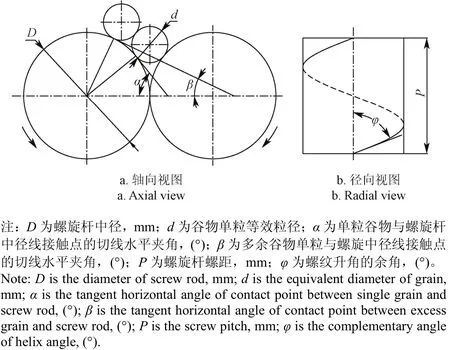
图4 双螺旋杆取样示意图Fig.4 Schematic diagram of double helix rods fetching
对中国水稻、小麦和大麦代表性主产品种谷粒外形尺寸进行测量,统计结果如表1所示。为了保证取样机构对不同谷物的兼容性,取所测谷粒最大等效粒径作为谷物等效粒径,即d取值5.18 mm。含水率为10%~30%的谷物与不锈钢表面的静滑动摩擦角为26°~40°,为了使谷物单粒在螺旋杆间平稳移动径向不脱落,谷物单粒与螺旋杆中径线接触点的切线水平夹角α取45°~50°,根据式(1)计算可得双螺旋杆中径为D=12.54~16.96 mm,取值16 mm。
确定双螺旋杆中径后根据式(2)可验证双螺旋杆旋转过程中径向剔除多余谷物的能力。

式中β为多余谷物单粒与螺旋杆中径线接触点的切线水平夹角,(°)。
由式(2)分析可知,谷物单粒等效粒径d越大,多余谷物与螺旋杆中径线接触点的切线水平夹角β越小,越容易剔除,所以验证计算时谷物单粒等效粒径d取表1中谷物等效粒径均值4.7 mm。由式(2)计算可得此时β=24.3°,小于谷物与光滑不锈钢表面的静滑动摩擦角,则多余谷物单粒在与双螺旋杆表面摩擦力的作用下被径向剔除出取样机构。

表1 谷物单粒外形尺寸测量统计表Table 1 Statistical table of single grain size measurement

式中P为螺旋杆螺距,mm;φ为螺纹升角的余角,(°)。综合考虑谷物与不锈钢表面的静滑动摩擦角和螺旋推送物料的平稳性与可靠性,φ取值80°,则螺距P由式(3)可得为8.86 mm,取值9 mm。
为使谷物单粒在双螺旋杆上水平移动过程中的连续和不越齿抛粒,选取螺纹压顶高和牙底高为2 mm,使等效粒径尺寸大小的谷物单粒的重心始终低于螺纹齿顶。双螺旋杆的长度决定同时承接谷物的数量,本设计只需保证螺旋齿间单粒输送,结合水分测定仪结构尺寸和安装的要求,双螺旋杆的长度取50 mm。
取样机构双螺旋杆旋转速度决定谷物单粒推入进料口的速度,影响完成一次水分值测量的用时。根据《电容法和电阻法粮食水分测定仪通用技术条件》[28]规定,
根据式(3)可计算出螺旋杆螺距P电阻法水分仪完成一次水分测量的时间应不超过1 min。以有效采样100粒谷物单粒阻值作为水分计算数据,异向正弦双螺旋杆每旋转半圈可向进料口推入1粒谷物,所以选取取样机构螺旋杆的转速为60 r/min,则完成一次水分数据采样的设计时间为50 s。
综上所述取样机构螺旋杆的设计参数如表2所示。
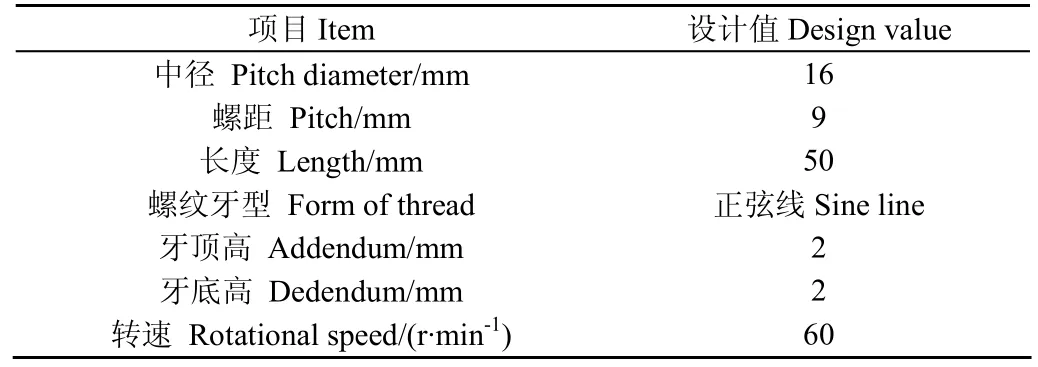
表2 谷物取样机构双螺旋杆设计参数表Table 2 Design parameters of double screw rods used in grain-fetched mechanism
2.1.2 谷物采样机构
连续单粒式谷物在线水分测定仪的采样机构由2个相互绝缘的不锈钢碾压辊构成,在异向旋转碾压谷物单粒时作为电极,探测被碾压谷物单粒的实时电阻值。碾压辊的直径、表面滚花、碾压间距和转速是影响有效性碾压的重要参数。所谓有效碾压是指谷物单粒被平稳均匀碾压,不产生跳粒、断裂和粘连现象。
碾压辊的直径和长度决定一对异向旋转碾压辊捕获单粒谷物的成功率,直径越大捕获成功率越高,综合结构设计要求确定碾压辊直径为55 mm,长度为12 mm。碾压间距为两碾压辊碾压面的最小距离,直接影响对谷物颗粒的碾压力,综合考虑碾压后谷物与碾压辊粘连程度,取碾压间距为0.4 mm[29]。采用弹性预紧机构将两碾压辊安装于水分仪壳体上,确保使用寿命内碾压间距保持不变。
碾压辊表面滚花类型则影响碾压的平稳性,常见表面滚花类型有直纹、斜纹和网纹(图5)。依据标准《滚花》规定的计算方法[30],直径55 mm不锈钢碾压辊滚花加工应选模数为0.4 mm的滚花刀,斜纹刀螺旋角选标准30°。选取模数为0.4 mm的直纹、斜纹和网纹3种滚花开展试验和模拟仿真研究,碾压平稳性优劣依次为斜纹、网纹和直纹滚花,故碾压辊表面滚花形式选择斜纹[31]。

图5 三种滚花形式的碾压辊Fig.5 Three kinds of knurling roller
从谷物单粒的组成结构可知,水稻、小麦和大麦的胚乳均被一层表皮包裹。谷物采样机构在进行碾压谷物单粒时须考虑表皮水分和胚乳水分的影响,因此谷物采样机构采用揉搓式碾压,两碾压辊的转速分别选取35和52 r/min。在两碾压辊捕获单粒谷物时,由于转速差的存在,谷物单粒表皮被碾压后迅速被拨裂,使碾压辊充分碾压谷物单粒的胚乳。单粒谷物阻值测量包括前期表皮阻值和后期胚乳阻值,计算输出的单粒谷物含水率值为表皮和胚乳的整体含水率。采样机构碾压辊的设计参数如表3所示。

表3 谷物采样机构碾压辊设计参数表Table 3 Design parameters of roller used in grain-sampled mechanism
2.2 信号采集电路设计
采样机构碾压谷物单粒时,信号采集电路周期性采集碾压过程中两碾压辊间的瞬态阻值,并保存碾压过程中全部瞬态阻值数据。单粒谷物碾压结束后,对所测所有瞬态阻值数据进行分析处理并计算出单粒谷物水分值。信号采集电路设计原理框图如图6所示。

图6 信号采集电路设计原理框图Fig.6 Schematic diagram of signal acquisition circuit design
2.2.1 多路复用比例电路
不同含水率的单粒谷物具有极宽的电阻域特性,比容积电阻范围可达10-2~1010Ω·cm[22]。常规比例法测量电路很难满足测量要求,为此本文设计了多路复用比例电路,电路原理图如图7所示。

图7 多路复用比例电路原理图Fig.7 Schematic diagram of multiplex proportional circuit
为保证比例电路复选开关的频率响应特性和减少开关接触电阻对标准比例电阻的影响,S1和S2选择Standex-Meder公司干簧管继电器。依据式(4)可计算出谷物等效电阻Rx

式中v1、v2和v3为电路节点电势值,V;Rx为谷物等效电阻,kΩ;Ri为第i路标准电阻值,kΩ;Ri的取值如表4所示。

表4 多路复用比例电路标准电阻取值表Table 4 Standard resistance value table of multiplex proportional circuit
2.2.2 滤波电路
为了提高信号采集电路的抗干扰能力,分别采用集成电路AD8643和LM358构成二阶压控有源低通滤波器和双T有源带阻滤波电路,能够有效抵抗1 kV浪涌和强度为3 A/m工频磁场的干扰。
2.2.3 A/D转换电路
多路复用比例电路输出的3路电压信号经过低通滤波器和50 Hz陷波电路滤波后输入A/D转换电路,选择Analog Devices公司的4通道16位双极性输入同步模数转换芯片AD7606-4构成A/D转换电路。本设计中AD7606-4选择并行接口和64倍过采样数字滤波。
2.2.4 微处理器系统
选择ST公司32位基于ARM CortexTM-M3核的STM32L151CBQ6低功耗微处理器构成微处理器系统核心,具有丰富功能配置和32MHz的CPU处理速度,满足水分仪大量数据计算处理和接口功能的要求。
2.2.5 电 源
连续单粒式谷物在线水分仪为DC24V供电,电源设计采用隔离稳压正负双输出DC-DC模块,隔离电压为3 kV,能有效抵抗1kV/5kHz的电快速脉冲群干扰。
2.3 水分计算方法
选取含水率10%~35%范围内的扬粳239、淮麦33和扬农啤4号作为稻谷、小麦和大麦的试验样品,在谷物温度为25 ℃时,使用电子万能试验机、高精度程控直流源和数字万用表,采用比例法测量不同含水率谷物单粒被碾压辊碾压时的直流电阻值,记录两碾压辊碾压间距为0.4 mm时的稳态阻值。相同水分值的样品测量100粒后取平均阻值。样品含水率采用《粮食、油料检验水分测定法》规定的105 ℃恒质量法测得[32]。根据试验数据得出如图8所示含水率与阻值关系曲线。

图8 谷物含水率与单粒电阻值关系曲线Fig.8 Relationship curve between grain moisture content and single grain resistance
对图8所示谷物单粒含水率与阻值关系曲线进行多项式回归,可得稻谷含水率计算公式(5)、小麦含水率计算公式(6)和大麦含水率计算公式(7)如下

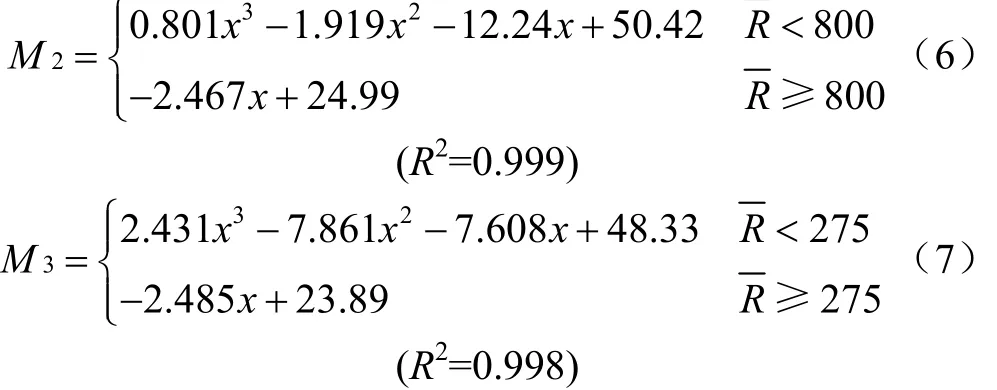
式中M1、M2、M3分别为稻谷、小麦和大麦的含水率,%;R为谷物单粒阻值平均值,kΩ;x为R的常用对数,数值等于lg(R);R2为方程的决定系数。
由公式(5)~(7)可知,谷物单粒含水率与阻值的对应函数关系在高水分和低水分时有所不同,相应的计算函数分界点对应的含水率分别为:稻谷为20%;小麦为18%;大麦为18%。
试验研究表明,谷物温度对其单粒电阻的影响显著,性质上表现为谷物单粒的电阻值随温度的升高而减小,变化规律基本符合−10~50 ℃条件下温升1 ℃对电阻的影响相当于含水率增大0.1%[33]。
2.4 软件设计
水分采样计算程序流程图如图9所示。
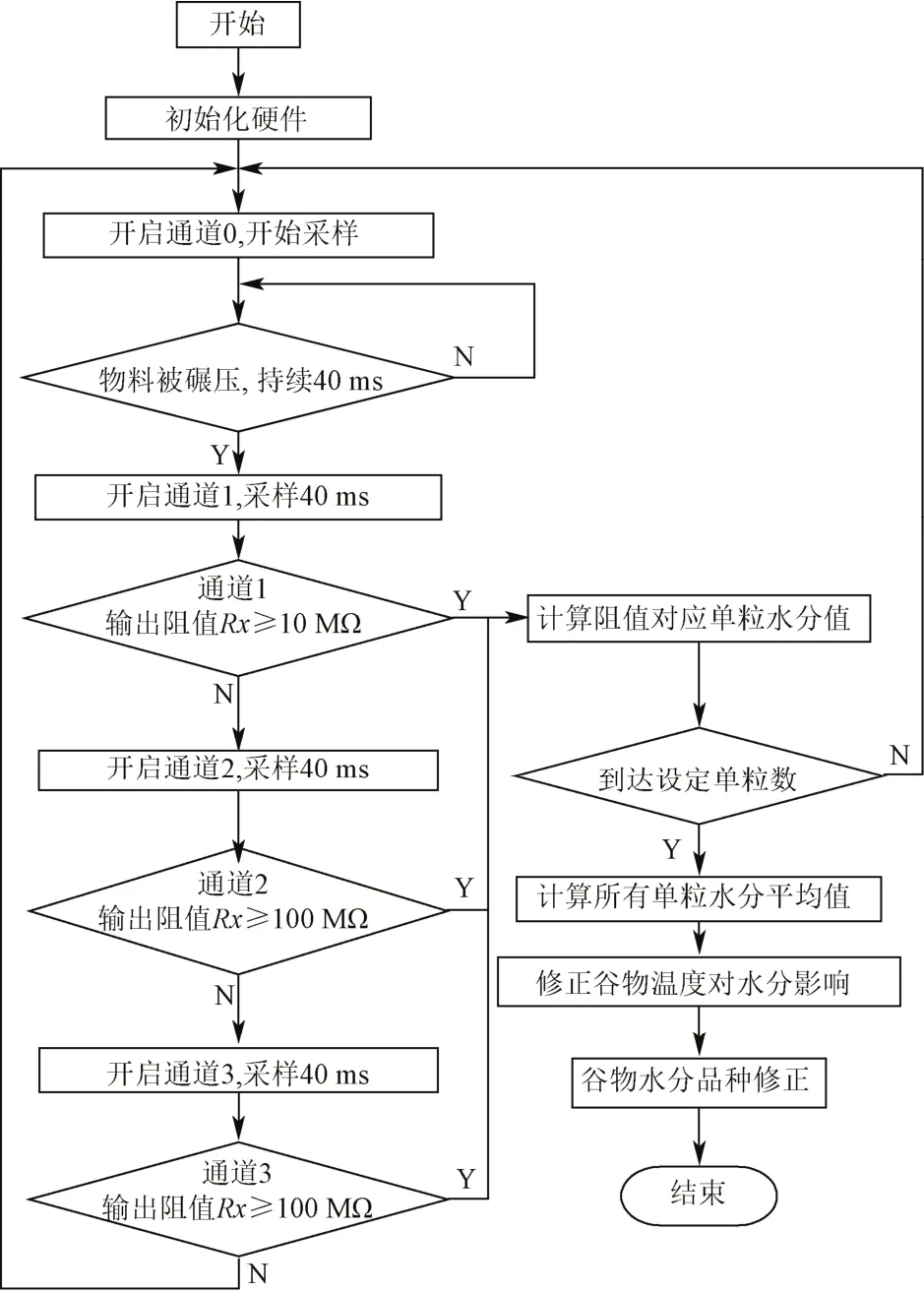
图9 谷物水分计算程序流程图Fig.9 Flowchart of grain moisture content calculation
单粒式谷物在线水分测定仪系统软件采用STM32固件库函数编程,在RVMDK5.12编程编译环境下完成。水分采样计算程序主要分两部分,一是单粒谷物阻值信号采样和水分计算,二是统计分析设定数量的单粒谷物水分值,计算输出本次采样水分值。单粒谷物阻值采样时,每个通道采样周期为1 ms,持续采样时间为20 ms的整数倍,以消除工频干扰的影响。采用中值法计算单粒谷物每个通道采样时间内所有阻值的平均值,并保存此平均值。每个通道输出阻值必须在该通道有效阻值范围内,否则判断本通道采样无效。根据单粒谷物有效平均阻值,计算出单粒谷物水分。被采样的谷物单粒数达到预设颗粒数时,结束本次水分采样,统计分析所有单粒谷物水分值,输出本次谷物水分采样最终水分值。
3 结果与分析
3.1 现场在线水分检测
为了验证连续单粒式谷物在线水分测定仪的准确性,在2013—2016年间分别在江苏、江西、山东和辽宁等地对连续单粒式谷物在线水分测定仪进行多批次稻谷、小麦和大麦水分在线测定验证试验。如图10所示。
考虑到循环式谷物烘干机装料后烘干仓内的谷物水分分布不均匀,在进行水分在线检测前,需采用自然通风循环2 h以上。烘干全过程中,每间隔1 h进行一次谷物水分在线检测,水分仪采样单粒数设为100粒,每次连续采样3个水分数值,记录这3个水分数值的平均值。在谷物在线水分仪采样水分的同时,人工从水分仪上方的提升机取料口连续匀速取样,直至水分仪3次水分采样结束,并将质量不少于1 kg的谷物样品置于密封袋保存。
3.2 烘干法水分检测
将现场取样保存在密封袋中的谷物样品放在实验室内,使其谷物温度与实验室保持的室温达到平衡。充分混合每袋中的谷物样品,然后依据标准《粮食、油料检验水分测定法》对谷物样品进行105 ℃恒质量法水分测定,并记录检测结果。
3.3 试验结果
连续单粒式谷物在线水分测定仪现场对谷物烘干过程中水分在线检测的重复误差和一次水分测量用时如表5所示。
试验结果表明,完成一次水分测量平均时间≤55 s,水分测量值重复误差≤±0.3%,优于原烘干机所装进口或国产在线水分仪一次水分测量平均时间≥90 s和水分测量值重复误差≤±0.5%的性能指标。与谷物样品105 ℃恒质量烘干法测得的水分值比较结果如表6所示。对比试验结果表明,水分测量值绝对误差≤±0.4%,绝对误差小于目前市场主流电阻式谷物在线水分仪绝对误差≤±0.5%的指标要求。符合谷物烘干过程水分在线检测的精度要求。

表5 在线水分仪含水率测量重复误差和测量用时Table 5 Repetitive errors and measuring times of moisture measurement for on-line moisture tester

表6 在线水分仪与烘干法测量水分结果比较Table 6 Comparison of measured moisture content between on-line moisture tester and drying method
4 结 论
1)采用一对不锈钢制异向正弦螺旋杆和分粒拨刀组成的谷物取样机构和斜纹表面滚花碾压辊组成的采样机构,连续采样100粒谷物单粒水分值计算谷物水分值,完成一次水分测量时间≤55 s,水分测量重复误差≤±0.3%。
2)设计多路复用比例电路为解决10-2~1010Ω·cm极宽比容积电阻精确检测,采用二阶压控有源低通滤波器和50 Hz陷波电路,使水分测定仪满足在线检测的电磁兼容性要求。
3)构建含水率在10%~35%范围内的稻谷、小麦和大麦单粒阻值与其含水率对应关系曲线,运用ARM CortexTM-M3核的低功耗32位微处理器硬件和软件平台,设计出连续单粒式谷物在线水分仪的水分采样、分析和计算软件。
4)现场在线验证试验可知,稻谷、小麦和大麦在温度−5~55 ℃和含水率10%~35%范围内,单粒式在线水分测定仪的水分测量值绝对误差≤0.4%,水分测量值重复误差≤0.3%,满足烘干过程水分在线检测的需求。对于其他品种的谷物烘干过程水分在线检测还有待后续研究。
[1] 束旭强. 粮食储藏期间水分变化的探讨[J]. 粮油仓储科技通讯,2004(5):52-54. Shu Xuqiang. Discussion moisture changes during food storage[J]. Grain and Oil Storage Technology Newsletter, 2004(5): 52-54. (in Chinese with English abstract)
[2] 余昆. 粮食储藏安全水分的分析与确定[J]. 粮食加工,2010,35(6):81-83,94. Yu Kun. Food storage security analysis and determination of moisture[J]. Food Processing, 2010, 35(6): 81-83, 94. (in Chinese with English abstract)
[3] 丁海滨,赵忠厚,周建新,等. 开展绿色储粮工程,确保国家储备粮安全[J]. 食品科学,2004,25(12):358-360. Ding Haibin, Zhao Zhonghou, Zhou Jianxin, et al. Developing green grain storage engineering to ensure security of state grain reserves[J]. Food Science, 2004, 25(12): 358-360. (in Chinese with English abstract)
[4] 靳祖训,兰盛斌. 减少粮食产后损失是确保粮食安全的重要途径[J]. 粮食储藏,2004,32(4):3-13. Jiu Zuxun, Lan Shengbin. Reducing post-harvest grain losses to guarantee grain safety[J]. Grain Storage, 2004, 32(4): 3-13. (in Chinese with English abstract)
[5] 吴文福,郭宏伟,徐岩,等. 基于粮食湿热平衡模型的吉林省粮食储藏生态区划[J]. 农业工程学报,2014,30(21):286-292. Wu wenfu, Guo Hongwei, Xu Yan, et al. Ecological regionalization of grain storage in Jilin based on water and heat balance model of grain[J]. Transactions of the Chinese Society of Agricultural Engineering (Transactions of the CSAE), 2014, 30(21): 286-292. (in Chinese with English abstract)
[6] 李长友,麦智炜,方壮东. 粮食水分结合能与热风干燥动力解析法[J]. 农业工程学报,2014,30(7):236-242. Li Changyou, Mai Zhiwei, Fang Zhuangdong. Analytical study of grain moisture binding energy and hot air drying dynamics[J]. Transactions of the Chinese Society of Agricultural Engineering (Transactions of the CSAE), 2014, 30(7): 236-242. (in Chinese with English abstract)
[7] 李长友,马兴灶,方壮东,等. 粮食热风干燥热能结构与解析法[J]. 农业工程学报,2014,30(9):220-228. Li Changyou, Ma Xingzao, Fang Zhuangdong, et al. Thermal energy structure of grain drying by analytical method[J]. Transactions of the Chinese Society of Agricultural Engineering (Transactions of the CSAE),2014, 30(9): 220-228. (in Chinese with English abstract)
[8] 李长友. 粮食热风干燥系统评价理论研究[J]. 农业工程学报,2012,28(12):1-6. Li Changyou. Exergy evaluation theory of hot air drying system for grains[J]. Transactions of the Chinese Society of Agricultural Engineering (Transactions of the CSAE), 2012, 28(12): 1-6. (in Chinese with English abstract)
[9] 张立辉. 谷物干燥过程模拟及测控新方法研究[D]. 长春:吉林大学,2014. Zhang Lihui. Research on Grain Drying Process Simulation and New Measurement and Control Methods[D]. Changchun: Jilin University, 2014. (in Chinese with English abstract)
[10] 胡志超,王海鸥,谢焕雄,等. 几种谷物横流干燥数学模型及其应用[J]. 农业工程学报,2010,26(增刊1):76-82. Hu Zhichao, Wang Haiou, Xie Huanxiong, et al. Mathematical models of crossflow grain drying and their applications[J]. Transactions of the Chinese Society of Agricultural Engineering (Transactions of the CSAE),2010, 26(Supp.1): 76-82. (in Chinese with English abstract)
[11] 李国昉,齐玉斌,李栋,等. 谷物干燥仿人智能控制系统[J].农业机械学报,2007,38(1):83-86. Li Guofang, Qi Yubin, Li Dong, et al. Human simulated intelligent controller for grain dryer[J]. Transactions of the Chinese Society for Agricultural Machinery, 2007, 38(1): 83-86. (in Chinese with English abstract)
[12] 张立辉,李春良,王立光. 连续谷物干燥机测控系统的设计[J]. 甘肃农业大学学报,2016,51(4):145-149. Zhang Lihui, Li Chunliang, Wang Liguang. Design for the control system of continuous grain dryer[J]. Journal of Gansu Agricultural University, 2016, 51(4): 145-149. (in Chinese with English abstract)
[13] 李光煜. 物料含水量微波检测系统关键技术研究[D]. 北京:北京理工大学,2014. Li Guangyu. Research on the Key Technology of Water Content Microwave Detection System[D]. Beijing: Beijing Institute of Technology, 2014. (in Chinese with English abstract)
[14] 汪小舟,陆正清. 微波加热法测定谷物水分的研究[J]. 广州食品工业科技,2004,20(3):115-116. Wang Xiaozhou, Lu Zhengqing. Study on microwave heat method measuring corn humidity content[J]. Guangzhou Food Science and Technology, 2004, 20(3): 115-116. (in Chinese with English abstract)
[15] 王江蓉,周京,沈娜,等. 近红外测定稻谷水分定标模型验证研究[J]. 粮食与饲料工业,2015(3):5-7. Wang Jiangrong, Zhou Jing, Shen Na, et al. Research on calibration model verification for determination of moisture content in paddy with near-infrared method[J]. Gereal & Feed Industry, 2015(3): 5-7. (in Chinese with English abstract)
[16] 杨柳,杨明皓,董兰兰. 主动屏蔽式平面探头水分在线传感器研究[J]. 农业机械学报,2010,41(1):77-80. Yang Liu, Yang Minghao, Dong Lanlan. Development of a coplanar electrode capacitance moisture sensor[J]. Transactions of the Chinese Society for Agricultural Machinery, 2010, 41(1): 77-80. (in Chinese with English abstract)
[17] 杨柳,毛志怀,董兰兰. 电容式谷物水分传感器平面探头的研制[J]. 农业工程学报,2010,26(2):185-189. Yang Liu, Mao Zhihuai, Dong Lanlan. Development of plane polar probe of capacitive grain moisture sensor[J]. Transactions of the Chinese Society of Agricultural Engineering (Transactions of the CSAE), 2010, 26(2): 185-189. (in Chinese with English abstract)
[18] 杨悦乾,王剑平,王成芝. 谷物含水率中子法在线测量的可行性研究[J]. 农业工程学报,2000,16(5):99-101. Yang Yueqian, Wang Jianping, Wang Chengzhi. Study on on-line measurement of grain moisture content by neutron gauge[J]. Transactions of the Chinese Society of Agricultural Engineering (Transactions of the CSAE), 2000, 16(5): 99-101. (in Chinese with English abstract)
[19] 宋平,徐静,马贺男,等. 用低场核磁共振检测水稻浸种过程中种子水分的相态及分布特征[J]. 农业工程学报,2016,32(6):204-210. Song Ping, Xu Jing, Ma Henan, et al. Moisture phase state and distribution characteristics of seed during rice seed soaking process by low field nuclear magnetic resonance[J]. Transactions of the Chinese Society of Agricultural Engineering (Transactions of the CSAE), 2016, 32(6): 204-210. (in Chinese with English abstract)
[20] 陈卫江,林向阳,阮榕生,等. 核磁共振技术无损快速评价食品水分的研究[J]. 食品研究与开发,2006,27(4):125-127. Chen Weijiang, Lin Xiangyang, Ruan Rongsheng, et al. Study on quick and non-destructive estimate the moisture content of food[J]. Food Research and Development, 2006, 27(4): 125-127. (in Chinese with English abstract)
[21] 张绪坤,祝树森,黄俭花,等. 用低场核磁分析胡萝卜切片干燥过程的内部水分变化[J]. 农业工程学报,2012,28(22):282-287. Zhang Xukun, Zhu Shusen, Huang Jianhua, et al. Analysis on internal moisture changes of carrot slices during drying process using low-field NMR[J]. Transactions of the Chinese Society of Agricultural Engineering (Transactions of the CSAE), 2012, 28(22): 282-287. (in Chinese with English abstract)
[22] 李长友. 稻谷干燥含水率在线检测装置设计与试验[J]. 农业机械学报,2008,39(3):56-59. Li Changyou. Design and experiment of on-line moisture content metering device for paddy drying process[J]. Transactions of the Chinese Society for Agricultural Machinery, 2008, 39(3): 56-59. (in Chinese with English abstract)
[23] 张永林,王旺平,郑长征,等. 谷物干燥实时在线智能水分测量系统[J]. 农业工程学报,2007,23(9):137-140. Zhang Yonglin, Wang Wangping, Zheng Changzheng, et al. Intelligent real-time on-line measuring system for moisture content during grain drying[J]. Transactions of the Chinese Society of Agricultural Engineering (Transactions of the CSAE), 2007, 23(9): 137-140. (in Chinese with English abstract)
[24] 梅庆,金亦富,张瑞宏,等. 谷物干燥水分在线测量系统设计[J]. 农机化研究,2015(9):241-244. Mei Qing, Jin Yifu, Zhang Ruihong, et al. Design of the grain moisture online measuring system[J]. Journal of Agricultural Mechanization Research, 2015(9): 241-244. (in Chinese with English abstract)
[25] 潘永康,王喜忠,刘相东. 现代干燥技术[M]. 北京:化工工业出版社,2006:945-969.
[26] 杨作梅,郭玉明,崔清亮,等. 谷子摩擦特性试验及其影响因素分析[J]. 农业工程学报,2016,32(16):258-264. Yang Zuomei, Guo Yuming, Cui Qingliang, et al. Test and influence factors analysis of friction characteristics of millet[J]. Transactions of the Chinese Society of Agricultural Engineering (Transactions of the CSAE), 2016, 32(16): 258-264. (in Chinese with English abstract)
[27] 程绪铎,陆琳琳,石翠霞. 小麦摩擦特性的试验研究[J]. 中国粮油学报,2012,27(4):15-19. Chen Xuduo, Lu Linlin, Shi Cuixia. The experimental research on friction properties of wheat[J]. Journal of the Chinese Cereals and Oils Association, 2012, 27(4): 15-19. (in Chinese with English abstract)
[28] GB/T 19878-2005,电容法和电阻法粮食水分测定仪通用技术条件[S].
[29] 杨作梅,孙静鑫,郭玉明. 不同含水率对谷子籽粒压缩力学性质与摩擦特性的影响[J]. 农业工程学报,2015,31(23):253-260. Yang Zuomei, Sun Jingxin, Guo Yuming. Effect of moisture content on compression mechanical properties and frictional characteristics of millet graint[J]. Transactions of the Chinese Society of Agricultural Engineering (Transactions of the CSAE), 2015, 31(23): 253-260. (in Chinese with English abstract)
[30] GB/T 6403.3-2008,滚花[S].
[31] 陈阳,胡志超,吴惠昌,等. 基于EDEM的单粒式谷物水分仪采样机构仿真研究[J]. 农机化研究,2016(7):239-244. Chen Yang, Hu Zhichao, Wu Huichang, et al. Simulation research on sampling mechanism of single resistance typed grain on-line moisture teller based on EDEM[J]. Journal of Agricultural Mechanization Research, 2016(7): 239-244. (in Chinese with English abstract)
[32] GB/T 5497-1985,粮食、油料检验 水分测定法[S].
[33] 杨兆选,鹿凯宁,刘承玺. 智能粮食湿度测试仪设计[J]. 电子测量与仪器学报,1996,10(3):64-66. Yang Zhaoxuan, Lu Kaining, Liu Chengxi. Design of the intelligent humidiometer to test grain’s damp[J]. Journal of Electronic Measurement and Instrument, 1996, 10(3): 64-66. (in Chinese with English abstract)
Design and experiment of continuous single grain typed on-line grain moisture test apparatus
Wu Huichang, Xie Huanxiong, Hu Zhichao※, Gu Fengwei, You Zhaoyan, Yan Jianchun, Wei Hai
(Nanjing Research Institute of Agricultural Mechanization, Ministry of Agriculture, Nanjing 210014, China)
Grain drying operation is an important part of food safe storage. In recent years, many scholars and engineers have done a lot of work on grain drying technology aiming to reduce energy consumption and realize automatic control of drying devices, but online moisture accurate detection in the grain drying that is core technique is still application difficulty to be solved, which restricts the development of grain drying system. Based on the analysis of the advantages and disadvantages of the technical principle of current online grain moisture meters, this paper presented a continuous single grain online moisture meter based on the water detection principle of resistance method. Physical dimensions of main varieties in main paddy, wheat and barley producing areas in China were measured, statistics of grain equivalent diameter were made, and pitch diameter and helix angle of stainless-steel incongruous sine screw rod were calculated by applying static sliding friction angle between single grain and metal surface. Therefore, the grain sampling device of moisture tester was designed, which was composed of a double-screw rod and a split grain knife. The grain sampling device screened out sundries and excess grain, and ensured single grain and continuity at the same time when sampling. According to the results of the experiment and simulation, 3 kinds of knurling forms with 0.4 mm modulus were chosen, including straight lines, oblique lines and net-mesh lines, and net-mesh lines had the optimal rolling smoothness among them, followed by straight lines knurling and oblique lines knurling. Considering the removal effect of adhesion on roller, the brushing effect of oblique lines knurling was the best, so the roller surface chose oblique lines form. Yangjing 239, Huaimai 33, and Yangnongpi 4 were chosen respectively as the test samples of paddy, wheat and barley, prepared as multiple samples with different moisture content. Meanwhile, when 105 ℃ drying method was adopted to test moisture content of each sample in the laboratory, the direct-current (DC) resistance of single grain with different moisture content compacted by the roller was measured by using universal electronic testing machine, programmable DC power supply with high precision, digital multimeter and other equipment; the steady resistance value was taken when the distance between the 2 rollers was 0.4 mm, and average resistance value was obtained after testing 100 samples for the samples with the same moisture content. Regression curves between the grain moisture content and single grain resistance of paddy, wheat and barley were built according to the experimental data. The calculation function expression of grain moisture content was obtained through polynomial regression on curve. Multiplex proportional circuit was designed, providing possibility to solve precise detection of extremely wide resistance of specific volume ranging from 10-2to 1010Ω·cm. Second order voltage-controlled active low-pass filter based on four-channel amplifier AD8643, and 50 Hz band-stop filter circuit consisting of operational amplifier LM358 were designed to meet the electromagnetic compatibility requirements for on-line grain moisture tester detection. Hardware and software platforms of ARM CortexTM-M3 core’s low power 32-bit microprocessor STM32L151CBQ6 were applied to finish both the sampling of grain moisture and the design of processing program. Online detection comparison tests on site showed that, when the drying temperature ranged from -5 to 55 ℃ and the moisture content ranged from 10% to 35% for paddy, wheat and barley, the online moisture measurement accuracy of the tester was less than ±0.5%, which satisfied online moisture detection requirements for the drying of the 3 kinds of grains. The design method can provide a reference for the online detection of water in the drying process of grain.
grain; moisture; electric resistance; single grain typed; low power 32 bit microprocessor STM32
10.11975/j.issn.1002-6819.2017.11.036
S237; TP206+.1
A
1002-6819(2017)-11-0282-09
吴惠昌,谢焕雄,胡志超,顾峰玮,游兆延,颜建春,魏 海. 连续单粒式谷物在线水分测定仪的设计与试验[J]. 农业工程学报,2017,33(11):282-290.
10.11975/j.issn.1002-6819.2017.11.036 http://www.tcsae.org
Wu Huichang, Xie Huanxiong, Hu Zhichao, Gu Fengwei, You Zhaoyan, Yan Jianchun, Wei Hai. Design and experiment of continuous single grain typed on-line grain moisture test apparatus[J]. Transactions of the Chinese Society of Agricultural Engineering (Transactions of the CSAE), 2017, 33(11): 282-290. (in Chinese with English abstract) doi:10.11975/j.issn.1002-6819.2017.11.036 http://www.tcsae.org
2017-02-21
2017-04-12
江苏省科技计划项目(BE2015301);中国农业科学院基本科研业务费专项(2016);中国农业科学院科技创新工程(农产品分级与贮藏装备创新团队)
吴惠昌,男,江苏扬州人,副研究员,主要从事农产品加工与农机装备智能化的研究。南京 农业部南京农业机械化研究所,210014。
Email:huichangwu@126.com
※通信作者:胡志超,男,陕西蓝田人,研究员,主要从事农作物收获及产后加工技术装备的研究。南京 农业部南京农业机械化研究所,210014。Email:nfzhongzi@163.com。中国农业工程学会高级会员:胡志超(E041200498S)
